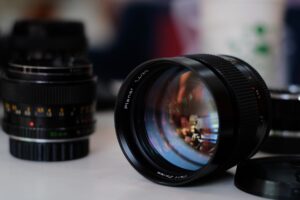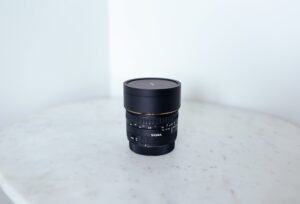So, what do camera lens numbers mean? Think of these numbers and letters as the lens’s ID card.
They reveal critical details like the aperture, focal length, lens diameter, focusing distance, and even the magnification ratio.
But, why should you care? Knowing how to read them can dramatically enhance your photography game, from shooting clear portraits to capturing wide landscapes.
Stick around, and we’ll decode these cryptic markings so you can focus on capturing that perfect shot.
| Term | What It Means |
|---|---|
| F-Number (Aperture) | Indicates lens speed. Lower numbers mean wider aperture, letting in more light. |
| Focal Length (mm) | Distance from lens to sensor; affects zoom level and angle of view. |
| Lens Diameter (Ø) | Size of the lens opening; crucial for filter compatibility. |
| Focusing Distance | Distance range within which the lens can focus; measured in meters and feet. |
| Magnification Ratio | Indicates how closely the lens can focus on a subject, crucial for macro photography. |
Stay tuned as we dive into each of these terms, providing real-world examples and tips to get the most out of your lenses.
Understanding Lens Markings
When you look at a camera lens, you’ll see various numbers and letters etched or printed onto the barrel, or maybe even displayed on a screen if it’s a more modern lens.
These markings can seem like an arcane language, but understanding them can empower you to make better choices—whether you’re choosing a new lens or making the most out of the one you’ve got.
But remember, these markings aren’t universal across all manufacturers; different brands may use slightly different abbreviations or placement.
How Manufacturers Mark Their Lenses
Camera lens manufacturers like Canon, Nikon, Sony, and Fujifilm use these markings to convey critical information about the lens.
This might include details about the lens’ construction, such as what kind of glass is used, to its capabilities like aperture range and focal length.
Some lenses may also have additional letters to indicate special features like image stabilization (IS for Canon, VR for Nikon), or the type of lens motor used for focusing.
Why Lens Markings Matter
Knowing how to read these markings can greatly benefit your photography in several ways:
- Choose the Right Lens: If you’re in the market for a new lens, knowing these numbers can help you make a more informed choice that fits your needs. For instance, if you know you need a fast lens that performs well in low light, you’ll likely want to look for one with a lower F-number.
- Optimize Your Current Gear: If you already own a lens or multiple lenses, understanding these markings can help you use them to their fullest potential. For instance, knowing your lens’s focusing distance can help you understand how close you can get to a subject and still maintain focus.
- Enhanced Compatibility: Knowing the diameter of your lens (often indicated by the Ø symbol) is crucial if you’re looking to buy filters or lens caps, as they need to match the lens’s size for proper fit.
- Specialized Photography: Some markings indicate if a lens is especially suited for macro photography or has built-in image stabilization, details that can be extremely helpful for specific kinds of photography.
In essence, these markings act as a cheat sheet for your lens’s capabilities and limitations. Ignoring them is like leaving a Swiss Army knife’s tools unused; sure, you can still cut things, but you’re missing out on its full potential.
For a deeper dive into camera lenses, be sure to check out our article on how do camera lenses work.
Would you like to know if camera lenses are universal or if lens protectors are necessary? Find out in our articles about are camera lenses universal and are camera lens protectors necessary.
The Basics: What Most Numbers and Letters Mean
F-Numbers: Your Guide to Aperture
Let’s break it down. F-Numbers are essentially a way to quantify the aperture, or the opening in the lens through which light passes.
The F-Number is usually represented with an “f/” followed by a number, like f/2.8 or f/16.
How F-Numbers Impact Aperture
- Lower F-Numbers: A smaller number like f/2.8 indicates a wider aperture. This means more light can enter, which is excellent for low-light scenarios. But remember, a wider aperture also means a shallower depth of field, so the focus will be narrow.
- Higher F-Numbers: On the flip side, a higher number like f/16 signifies a smaller aperture. While this lets in less light, it also means a broader depth of field, allowing more elements in your frame to be in focus.
Relevance of Aperture to Photography
Understanding aperture is vital because it directly impacts your photography in various ways:
- Light Control: Aperture is one-third of the exposure triangle, along with shutter speed and ISO. A wide aperture is handy for low-light conditions, whereas a smaller one is better when there’s an abundance of light.
- Depth of Field: It helps you control how much of the scene is in focus. Want a creamy background bokeh? Opt for a wider aperture. Need everything in sharp detail? Go for a narrower one.
- Sharpness: Some lenses are sharper at specific apertures. For instance, a lens might be incredibly sharp at f/8 but less so at f/2.8 or f/16.
By understanding F-Numbers, you can make more informed decisions about how to set up your shot. It enables you to manipulate the depth of field and light exposure, which are key to capturing the image you envision.
Lens Diameter: What Does Ø Mean?
Meet Ø, a symbol that often creates perplexity but is actually pretty straightforward.
The diameter symbol “Ø” followed by a number (usually in millimeters) represents the lens’s physical opening size.
For instance, a lens marked Ø77 has a 77mm opening.
Significance of Lens Diameter
- Filter Compatibility: The most immediate practical application of knowing your lens diameter is for filter compatibility. If you’re going to invest in lens filters, you need to know what size fits.
- Light Entry: Although not as critical as the aperture, the lens diameter can also affect the amount of light entering the lens. A larger diameter generally allows more light to pass through.
- Lens Design: Diameter can sometimes give you a clue about the lens’s design complexity. Lenses with larger diameters often contain more glass elements or have a wider aperture, although this is not a strict rule.
Are Filters Really Necessary?
If you’ve ever questioned the need for lens filters, you’re not alone. Filters can serve various purposes, from UV protection to polarization effects that enrich your photos.
Knowing your lens diameter ensures you purchase the correct filter size, avoiding any vignetting or fitting issues.
For a deeper dive into the world of filters, check out our in-depth article on Are Lens Filters Necessary?
Advanced Lens Numbers
Focusing Distance, Meters and Feet
Alright, you’ve got the basics down. Let’s step into the more nuanced world of lens markings.
When you see numbers followed by ‘m’ for meters or ‘ft’ for feet, you’ve hit the focusing distance. These numbers define the range within which your lens can crisply focus on a subject.
This feature is particularly critical for macro and portrait photography, where a shallow depth of field is often desirable.
- Interpreting the Distance: The focusing distance is usually marked on the lens barrel or within the camera settings for lenses with electronic displays. It helps you understand how close or how far you can be from your subject and still get that sharp image.
- Manual vs. Auto Focusing: Knowing the focusing distance becomes particularly helpful if you’re using manual focus. With autofocus, the camera will alert you if you’re out of range, but manual focusing often requires a more hands-on approach.
What About Hyperfocal Distance?
If you’re into landscape photography, say hello to your new best friend: hyperfocal distance.
This is the closest distance at which you can focus while keeping everything from half of this distance to infinity sharp in your frame.
Confused? Don’t be. Once you set your lens to the hyperfocal distance, you maximize your depth of field, making sure both the foreground and background are in focus.
So, why is this so crucial? It helps you capture rich, multi-layered landscapes without sacrificing sharpness. It’s an important tool in your arsenal to master the art of landscape photography.
Focusing distance and hyperfocal distance are advanced lens concepts that, once mastered, can open a new realm of photographic opportunities.
Lens Type, Special Materials, and Internal Focusing
Ready to get a bit more advanced? Let’s talk lens types, special materials, and internal focusing. These often-overlooked details can actually have a huge impact on your photography.
Lens Types: The Alphabet Soup
Ever seen something like “FE” or “PZ” printed on your lens and wondered what it means? These are indicators of lens type and they’re quite important:
- FE: This stands for “Full-Frame E-mount.” An FE lens is designed to cover a 35mm sensor and is compatible with cameras that have a full-frame sensor. So, if you’re aiming for professional-grade photos, look for this.
- PZ: Say hello to “Power Zoom.” This means the lens has an electronic zoom mechanism, handy for smooth zooming in video recording.
Special Materials: What Your Lens is Made Of
Some manufacturers use special materials in their lenses, usually to reduce weight or increase durability. You might see terms like “Aspherical” or “ED” (Extra-low Dispersion).
These details can affect image quality, so they’re worth paying attention to:
- Aspherical Lenses: Help to correct distortion and are generally lighter.
- ED Glass: Minimizes chromatic aberration, improving sharpness and color accuracy.
Internal Focusing
Internal Focusing (IF) is a feature where the lens adjusts the focus by moving elements inside the lens barrel. This means the front of the lens doesn’t rotate and extend, which is beneficial for several reasons:
- Quick Autofocus: Because less glass is moving within the lens, autofocus can be quicker.
- Filter Use: Because the lens front doesn’t rotate, it’s easier to use polarizing filters.
Other Lens Features and Abbreviations
Just when you thought you’ve got it all down, here comes another batch of abbreviations, buttons, and dials. Don’t worry; these are the cherries on top that can supercharge your photography game.
Buttons and Dials
- AF/MF Switch: This is a basic but vital feature. The “Auto Focus/Manual Focus” switch allows you to quickly toggle between automatic and manual focusing.
- Stabilization Button: Many lenses offer some form of image stabilization. Activating this can be a game-changer in low-light conditions or when your hands just can’t stay still.
- Custom Buttons: Higher-end lenses often have custom buttons that you can program to perform specific functions, like exposure lock. It’s like having shortcuts right on your lens!
Abbreviations: The Mini-Glossary
- IS/VR/VC: These stand for “Image Stabilization” (Canon), “Vibration Reduction” (Nikon), and “Vibration Compensation” (Tamron). Different names, same game: they help reduce camera shake.
- USM/SWM/HSM: Say hello to ultrasonic motors. These abbreviations stand for “Ultrasonic Motor” (Canon), “Silent Wave Motor” (Nikon), and “Hyper-Sonic Motor” (Sigma). What’s the big deal? Faster and quieter autofocus.
- LD/HD: “Low Dispersion” and “High Definition” are terms used to describe the quality of the glass in the lens. LD and HD lenses usually provide better sharpness and less chromatic aberration.
- WR: This stands for “Weather Resistant.” If you’re an adventurer who likes to shoot in various conditions, a WR lens is your best friend.
- MTF Charts: You may sometimes see this on lens packaging or manuals. “Modulation Transfer Function” charts are graphs that technically evaluate a lens’s image quality.
Storing and Maintenance
Owning lenses is only half the story—maintaining them is the other half. Let’s talk about how to store and keep those lenses in tiptop shape.
- Storage Conditions: The environment matters. Keep your lenses in a cool, dry place. Humidity is a lens’s worst enemy. Use silica gel packs to absorb moisture.
- Lens Caps On: Never underestimate the power of a simple lens cap. It’s your first line of defense against dust and scratches.
- Regular Cleaning: Wipe down your lenses with a microfiber cloth and lens cleaner. But do it gently. Aggressive scrubbing can damage the lens coating.
- Use Lens Cases: When not in use, lenses should be stored in padded cases. This is especially important if you’re moving around a lot.
- Check for Fungus: Moist environments can lead to lens fungus, which is as nasty as it sounds. Regular checks can prevent irreparable damage.
For more in-depth guidance, check out our article on How to Store Camera Lenses Properly.
Conclusion
Whew, we’ve covered a lot of ground, haven’t we?
From F-Numbers to fancy buttons, you’re now equipped to make informed decisions about camera lenses. You know what those numbers and letters stand for and, more importantly, what they mean for your photography.
So, what’s stopping you? Go explore the world of lenses with your newfound expertise. The perfect shot awaits, and now you have the knowledge to capture it just the way you envisioned.









Pingback: The Best Lens for Moon Photography in 2023 - Photography Explorer
Pingback: The Best Camera Lens for Sports Photography [2023] - Photography Explorer